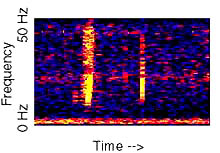
June 30, 2002 Woods Hole, Massachusetts - The June 13, 2002 issue of New Scientist featured an article by reporter John von Radowitz in London about an underwater sound deep in the ocean recorded in 1997 by NOAA scientists that remains unidentified. The "Bloop" was detected and recorded from an array of underwater hydrophones (microphones) originally set up by the U. S. Navy in the 1960s to track Soviet submarines. The listening technology is distributed in a deep ocean level known as the "sound layer" which marine animals such as whales and human technology such as submarines use for long-range communication.

The "Bloop" was detected by hydrophones up to 4,800 kilometers apart (2,983 miles). That is a long distance for a single sound to be heard. Thus, speculation began about what the "Bloop" might be. The New Scientist article stated that the great distance it covered "meant it had to be much louder than any recognized animal noise, including that produced by the largest whales."
Recently, NOAA scientist Chris Fox who originally recorded the "Bloop," sent one recording to Dr. Phil Lobel, a marine biologist at the Woods Hole Laboratory in Massachusetts and a Professor of Marine Biology at Boston University. Dr. Lobel studies underwater sounds made by fish and other marine animals. I asked him what he thought the Bloop could be.
Click here to subscribe and get instant access to read this report.
Click here to check your existing subscription status.
Existing members, login below:
© 1998 - 2024 by Linda Moulton Howe.
All Rights Reserved.

